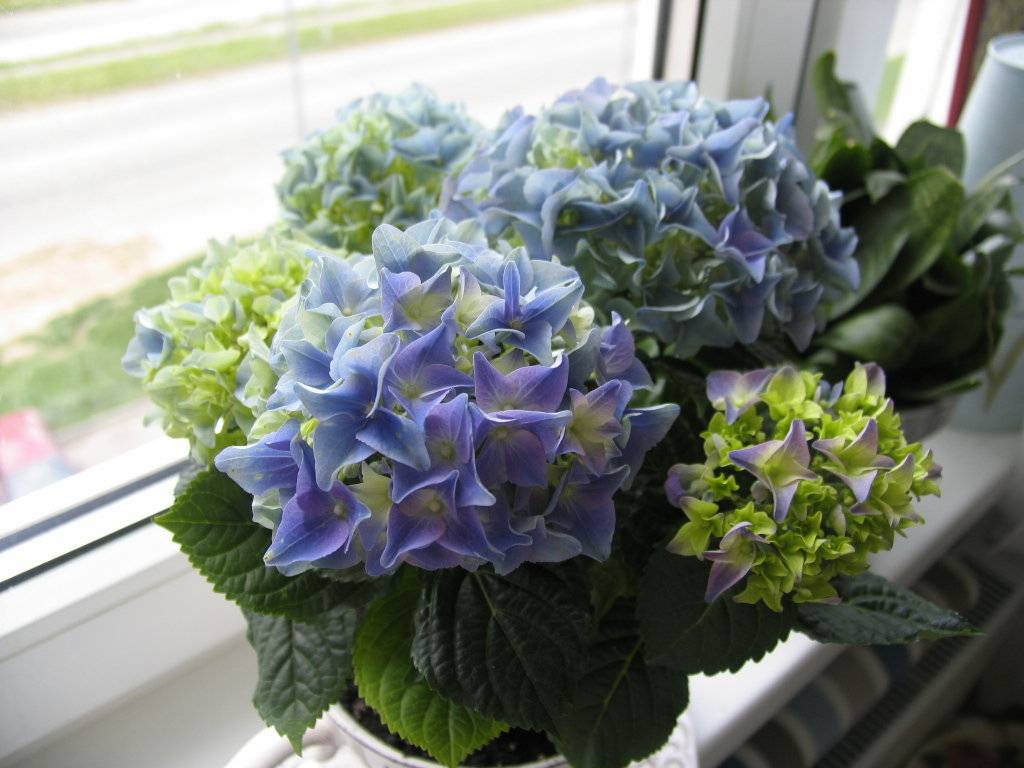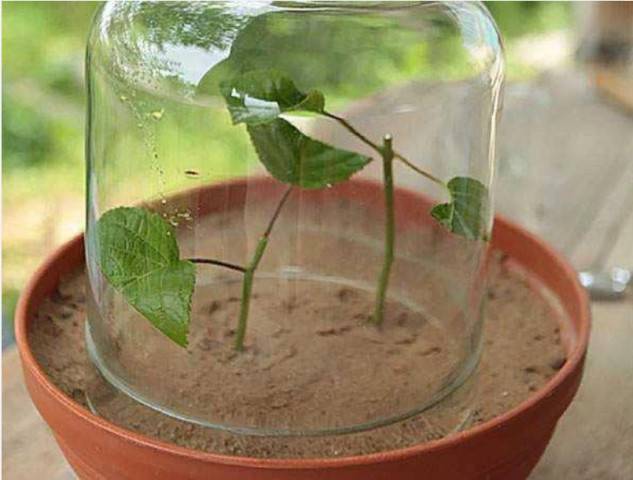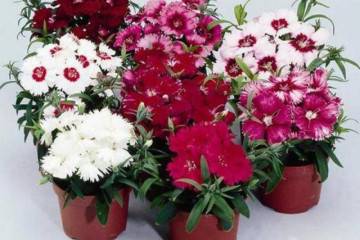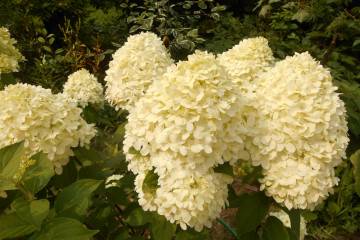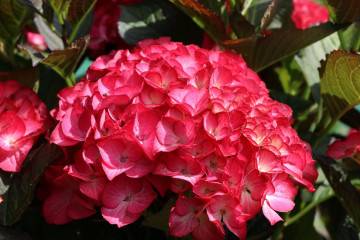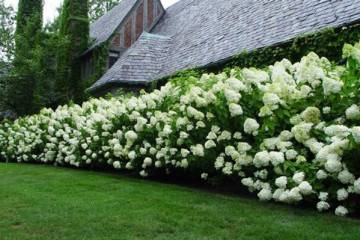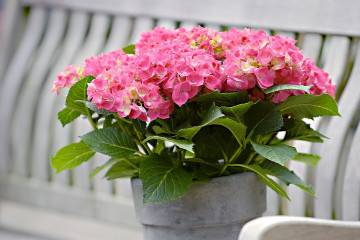Indoor hydrangea - home care
Content:
Indoor hydrangea can easily decorate any home. In an apartment, it can reach 1.5 m in height. During the flowering period, which lasts quite a long time, the plant looks gorgeous. That is why many flower growers strive to get it into their collection. Having provided the necessary conditions for the normal growth and development of the flower, you can admire it for many years. The article below describes home hydrangea, home care for it. Everyone can cope with its cultivation.
Description of indoor hydrangea
Home hydrangea comes from garden hydrangea, which is grown in many flower beds, being a real decoration of the garden.
Origin and appearance
For the first time information about hydrangea appeared in 1768, when the participants of the first French round-the-world expedition saw it on about. Mauritius. The name of the beautiful flower was given in honor of the sister of the prince of the Holy Roman Empire - Hortense. From Mauritius, it was brought to Europe, where it became widespread as a garden plant, and later domesticated it.
Botanical description of a hydrangea growing in a pot:
- life form - shrub up to 1.5 m high;
- oval-shaped leaves with jagged edges of green;
- spherical inflorescences up to 20 cm in diameter;
- inflorescence forms - umbrella, racemose, corymbose;
- flower petals are colorless, and sepals are brightly colored, the color of which does not depend on the variety, but on the soil in which the plant grows. In a neutral medium, the flowers will be creamy or white, in an acidic medium they will be blue, and in an alkaline medium they will be pink or lilac.
Types and varieties of hydrangeas for indoor cultivation
Not all street hydrangea varieties are domesticated. But there are those that are found on the windowsills of flower growers most often. Breeders continue to work on various types of hydrangeas.
Compact
The Kompakta variety is a low-growing shrub with lush foliage and brightly colored leaf plates. The maximum height of the bush is 50 cm. The inflorescences are exceptionally spherical. Depending on the acidity level of the soil, the flowers are white or pinkish. The first inflorescence appears in late June - early July and is always white with a pearlescent tint.
Madame E. Muyer
The garden variety of the variety is distinguished by its increased frost resistance, for which the inhabitants of Siberia and the Urals love it very much. The indoor version of Madame Mile is a large-leaved shrub with an impressive green part. The upper part of the bright green leaves is glossy, the lower part is covered with fine fluff. Inflorescences are spherical. It begins to bloom in early July, the last flowers last until early autumn.
Europa
Europa is another large-leaved hydrangea species. Leaves are bright green with fringed edges.The color depends on the acidity of the soil and can be either bright red or deep purple. The most common shades are delicate blue.
Souer tharese
This variety can be easily distinguished from others by its large snow-white inflorescences. But this color is preserved only with neutral acidity of the soil. In other cases, it can change and become lilac or light blue. In acidic soil, the flowers will turn pink.
Red sensation
The name of the variety speaks for itself: the flowers of this hydrangea are surprisingly bright, juicy red shades: from burgundy to crimson. If the soil is very acidic, wine, almost purple tones will appear. This flower will become the center of any floral arrangement.
Ramars mars
Ramars Mars differs from other hydrangeas in that it changes the color of the petals during the flowering period. At first they are pale blue, gradually turning into lilac. But if you work on the level of acidity of the soil, then you can achieve bright purple balls.
Earley Blue
Earley Blue attracts with its original flowers. Their shade smoothly flows from a light green base to the rich blue edge of the petals. The color changes gradually throughout the summer.
Goliath
As the name implies, the Goliath variety is very large in the garden. In addition, this hydrangea is also frost-resistant, strong. The smaller room copy also combines many of the features of its tall fellow. It is a panicle type of hydrangea. Its flowers are elongated, conical, located one by one on the shoot. The shade is often always white, maybe pink.
Transplanting indoor hydrangeas after purchase into pots
You can transplant a flower only after flowering and after the annual autumn pruning has been done. That is, with an early purchase during the flowering period, the hydrangea may well wait in the same flowerpot in which it grew in the store. If the acquisition took place in the fall, then you should wait a couple of weeks and only after that start planting a flower in a new pot.
What is needed for landing
The new planter should be 3-5 cm wider than the previous one. The pot should not be deep, but wide enough, since the plant has a fibrous, not tap root system. A transplant into a new flowerpot is carried out annually in the fall. During the winter (dormant period), she will get used to it, and in the spring it will begin to develop in full power and bloom even more magnificently.
Choosing the best place
The best place for a flower will be one that has enough light, but without direct sunlight. A distance of 3-4 m from the window will be suitable. This is where the hydrangea will feel great. This rule applies to southern windows. In the east or west, a windowsill location is suitable, since the sun's rays are there in the morning or evening.
Step-by-step planting process
First of all, before planting the plant in a new pot, it is necessary to prepare the potting mix. You can buy a ready-made substrate for hydrangeas, you can make it yourself: for 2 parts of the turf, you will need 1 part of sand and peat. The bottom of the pot must be drained.
Step-by-step instructions for planting hydrangeas:
- Prepare everything you need for transplanting, put a good layer of drainage on the bottom of the new pot.
- Water the plant in the container in which it grows. Due to the fact that the earth will be moist, the earthen lump together with the flower will more easily slip out of the pot.
- Transplant a flower from one pot to another by transshipment.
- Fill all voids with prepared soil.
- Drizzle with plenty of liquid.
Reproduction of indoor hydrangeas
Hydrangea can propagate in two ways: by cuttings and seed germination. The first method is faster, but the second will contribute to the cultivation of more young bushes at the same time.
Reproduction can also occur by dividing the bush. This is the easiest way. You need to let the plant bloom and during the autumn transplant, just separate part of it and plant it in a new pot. During the winter, both parts will get used to the new conditions and will delight you with lush flowering next season.
Propagation by cuttings
The upper part of the stem 5-6 cm long is used as a cutting. It is cut off, placed in wet sand and covered with a plastic bottle or glass jar. The greenhouse is periodically opened for ventilation and humidification. Further care for cuttings is the same as for adult hydrangeas.
Growing from seeds
Before growing seeds, you need to know that their germination rate is not very high, only 60%. Planting material, without any preliminary preparation, is simply laid on the top layer of soil, identical to that in which adult hydrangeas are planted. From above the container with seeds is covered with plastic wrap and glass. They are placed in the same place as adult plants. Every day they need to be slightly opened for ventilation in order to avoid the development of viral and fungal diseases, mold, after which no means of treatment and resuscitation will help the seedlings.
You can plant seedlings when 2 real leaves appear.
Caring for potted hydrangeas
Caring for a room hydrangea at home is not very difficult, and if everything is done correctly, the flower will thank the owner with its lush flowering throughout the season. The main thing is to isolate the plant from drafts, otherwise the leaves will begin to wither, and nothing will help them.
Watering mode
The second name of hydrangea is hydrangea, which is translated from Greek as "a barrel of water". This is due to the fact that the flower is unusually hygrophilous. But the water should be warm, room temperature, soft. In the summer, it needs to be watered often and abundantly, and in the winter, during the dormant period, watering is sharply reduced.
The yellowing of the leaves of a plant signals that it lacks acid. In such cases, when watering, you need to add a little lemon juice: 5 drops per 1 liter.
Air humidity is also important, it should be high. It is helpful to purchase a humidifier. Also shown are regular spraying from a spray bottle.
Top dressing
From the beginning of the growing season until the onset of the dormant period, the hydrangea needs constant feeding with both mineral and organic fertilizers. As a rule, they alternate. The amount of nutrients depends on the size of the bush. Periodically, it is useful to add a solution of potassium permanganate to the water for irrigation.
Features of care during flowering
Flowering plants cannot be transplanted. The optimum temperature during this period is 18-22 ° C. You can take out pots with a blooming beauty on a balcony or veranda. At this time, top dressing and frequent abundant watering are especially important.
Features of care during the rest period
Before the dormant period begins, the hydrangea must be pruned.After that, put the pots with it in a room with a temperature of 5-8 ° C. This must be done without fail. If the flower is left in the room, it will not rest and will not bloom in the new season.
In the conditions of an apartment, you can transfer the plant to the basement (if any), to a closed balcony or an unheated staircase. In winter, hydrangea should be watered periodically. It should not be as abundant as in the summer, rather, meager. But the root system should not dry out completely, otherwise it may not recover in spring, and the plant will die.
Preparing for winter
After flowering, before sending the hydrangea to winter, all sick, old shoots are removed. They will interfere with others and can infect them with dangerous diseases. A compulsory transplant into a new pot is also carried out. After that, the flower is carried away for the winter.
The question of how to care for a hydrangea in a pot scares many inexperienced growers. But in reality it turns out that there is nothing complicated about it. Following all the instructions, you can annually enjoy the lush and bright flowering, discovering all the new unusual properties of this flower: from changing colors to its unusual medicinal properties.
Particularly good is the already adult indoor hydrangea, which has reached its maximum growth and blooms every year more and more magnificently. The most common problem is where to send the flower for the winter. But it is quite solvable: if there is no cool place at home, you can take him to the country, to friends or relatives. This flower is well worth the effort.




